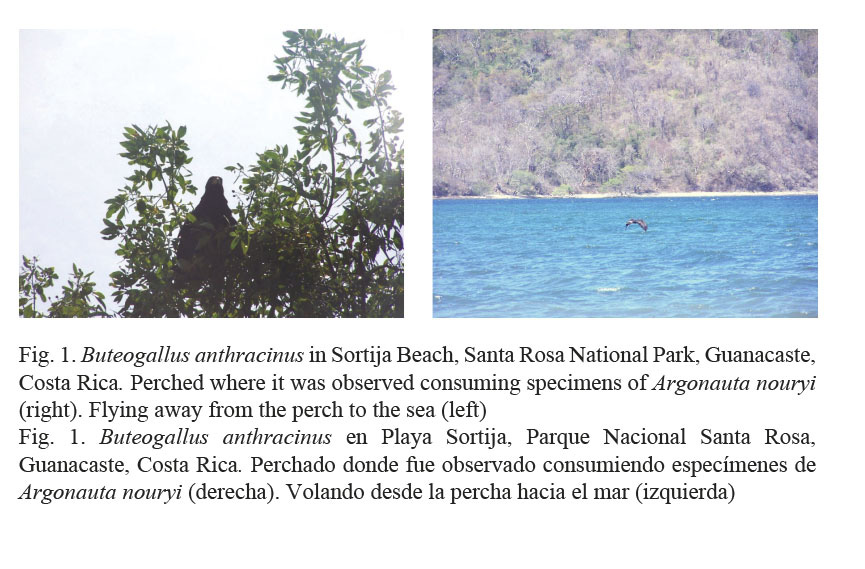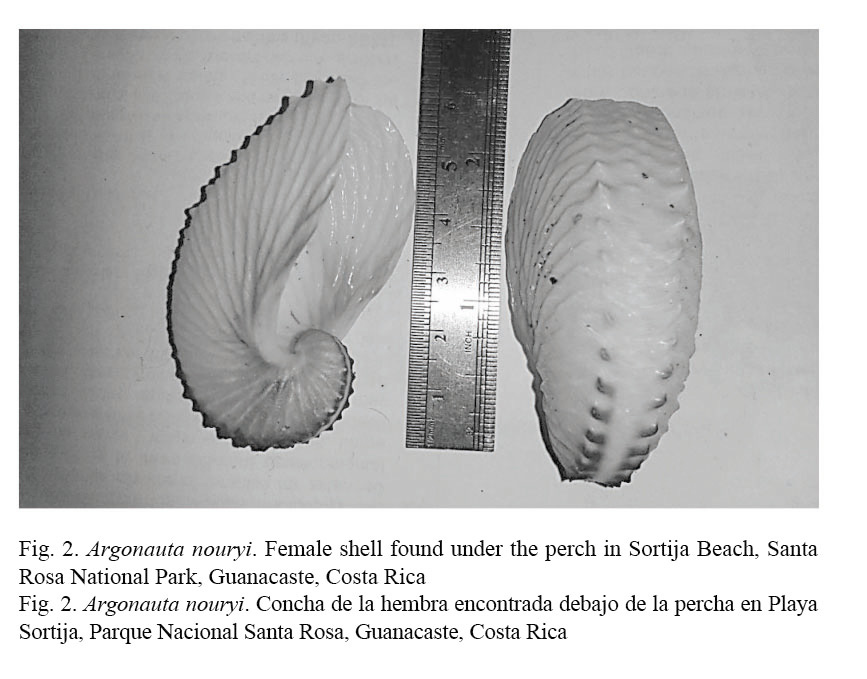Rev. Mar. Cost. ISSN 1659-455X. Vol. 9 (1): 85-89, Enero-Junio 2017.
DOI: http://dx.doi.org/10.15359/revmar.9-1.5
First record of predation of the paper nautilus Argonauta nouryi (Cephalopoda: Argonautidae) by the Common Black Hawk Buteogallus anthracinus (Accipitriformes: Accipitridae)
Primer registro de depredación del nautilo de papel Argonauta nouryi (Cephalopoda: Argonautidae) por el Gavilán Cangrejero Buteogallus anthracinus (Accipitriformes: Accipitridae)
Federico Herrera1* y Mónica González1
1 Ciencias Exactas y Naturales, Universidad Estatal a Distancia, UNED, 474-2050, San Pedro de Montes de Oca, San José, Costa Rica. fherreram@uned.ac.cr*, mgonzalezn@uned.ac.cr
Recibido: 07 septiembre 2016
Corregido: 19 mayo 2017
Aceptado: 22 mayo 2017
ABSTRACT
Predation of cephalopods by non-marine birds is rare, especially within the Order Accipotriformes. Observations took place in situ and identification of Argonauta nouryi was entirely based on the shell form. The predation of the paper nautilus, A. nouryi, by the Common Black Hawk, Buteogallus anthracinus, is reported for the first time at the Murciélago Sector of the Santa Rosa National Park, Guanacaste, Costa Rica. This represents the first known bird predator of this species within the country.
Keywords: Predation, Santa Rosa National Park, Costa Rica, cephalopod, behavior, hawk.
RESUMEN
La depredación de cefalópodos por parte de aves no marinas es rara, sobre todo en aves del orden Accipitriformes. Las observaciones se llevaron a cabo in situ y la identificación de Argonauta nouryi fue completamente basada en la forma de la concha. Se registra por primera vez la depredación del nautilo de papel, A. nouryi, por el Gavilán Cangrejo, Buteogallus anthracinus, en el Sector Murciélago del Parque Nacional Santa Rosa, Guanacaste, Costa Rica, lo cual representa la primera ave conocida depredadora de esta especie en el país.
Palabras claves: Depredación, Parque Nacional Santa Rosa, Costa Rica, cefalópodo, comportamiento, gavilán.
INTRODUCTION
In Costa Rica, there are four valid species of the genus Buteogallus Lesson, 1830. Stiles & Skutch (2003) report three taxa, Buteogallus anthracinus (Deppe, 1830), Buteogallus urubitinga (Gmelin, 1788) and Buteogallus solitarius (Tshudi, 1844). The last species reported for the genus in the country is Buteogallus meridionalis (Latham, 1790) (Obando-Calderón et al. 2008).
Regarding B. anthracinus, it has been reported to prey mainly on crabs complemented by reptiles, frogs, sea turtle eggs and hatchlings, frogs, snakes, crayfish, lizards, large insects, stranded fishes and carrion, always near water such as mangroves, coasts, marshes, and swamps (Stiles & Skutch, 2003; Ferguson-Lees & Christie, 2010).
Regarding the genus Argonauta Linnaeus, 1758, and according to Finn (2014), there are four described species in the world and on the Pacific Coast of Costa Rica only two species can be found, Argonauta argo Linnaeus, 1758 and Argonauta nouryi Lorois, 1852.
The first record of predation of the paper nautilus, A. nouryi, by the common black-hawk, B. anthracinus, is herein presented.
MATERIALS AND METHODS
Observations by the authors took place in Sortija Beach (10° 55ʼ 36ʼʼ N, 85° 49ʼ 07.78ʼʼ W), Gulf of Santa Elena, Murciélago Sector, Santa Rosa National Park, Guanacaste province, Costa Rica. Bird species were identified in situ using binoculars, following the information proposed by Stiles & Skutch (2003).
Sightings took place on August 3rd, 2011, CST 10:27. The bird was observed several times consuming specimens of A. nouryi, dropping their shells to the ground, and piling them up, while remaining perched on a small tree (3 to 4 meters tall) very close to the shore (Fig. 1). After eating them, it left the perch and headed to the sea again to come back to the perch after a while with a new argonaut to consume.

Identification of A. nouryi was entirely based on the shell form (Fig. 2), using the information proposed by Finn (2014). The time lapse between observations and the preparation of this report was due to the difficulty to identify the paper nautilus species and the considerable confusion existing for centuries among taxonomists until the recent studies by Finn (2013; 2014). Female shells of A. nouryi were collected, right under the perch after being dropped by B. anthracinus, and were deposited (specimens MZUCR10424-01) at the Museum of Zoology of Universidad de Costa Rica, MZUCR.

DISCUSSION
In Costa Rica reports of cephalopod predation by birds in the literature is rare and only for squids. Stiles & Skutch (2003) reported predation of squids in six marine bird families. Procellariidae, Galapagos Petrel, Pterodroma phaeopygia (Salvin, 1876); Phaethontidae, Red-billed Tropicbird, Phaethon aethereus Linnaeus, 1758; Stercorariidae, Pomarine Jaeger, Stercorarius pomarinus (Temminck, 1815); Sulidae, Blue-footed Booby, Sula nebouxii Milne-Edwards, 1882; Fregatidae, Magnificent Frigatebird, Fregata magnificens Mathews, 1914 and Great Frigatebird, Fregata minor (Gmelin, 1789); Laridae, Sooty Tern, Onychoprion fuscatus (Linnaeus, 1766), Bridled Tern, Onychoprion anaethetus (Scopoli, 1786) and Sandwich Tern, Thalasseus sandvicensis (Latham, 1787).
On the other hand, the genus Argonauta has been reported to be consumed by different marine birds within the American continent, but none of them present in Costa Rica, such as the species mentioned by Imber (1992), Croxall & Prince (1996), Fonseca et al. (2001), Fonseca & Petry (2007) and Pinto et al. (2007).
Strandings of argonauts have been reported by Grove (2014) and by Grove & Finn (2014) in Tasmania, but in Sortija beach no strandings or other shells were observed, except for the ones piled up under the perch. This reinforces that B. anthracinus was fishing them directly from the sea and not collecting them from the ground of the shore. We consider B. anthracinus is an opportunist and the changes in its diet are primarily due to food availability, as affirmed by Rodríguez-Flores et al. (2010).
This observation is key to demonstrate the complex trophic interactions between the two species, which were unknown to exist. This observation is also key because no bird species has been reported to consume A. nouryi in Costa Rica before and it represents the first record of predation of a cephalopod by a member of the genus Buteogallus.
BIBLIOGRAPHY
Croxall, J. & Prince, P. A. (1996). Cephalopods as prey. I. Seabirds. Philos. T. Roy. Soc. B, 351(1343), 1021-1041. doi: http://dx.doi.org/10.1098/rstb.1996.0091
Ferguson-Lees, J. & Christie, D. A. (2010). Raptors of the World: a field guide. Digital Edition. London, England: A & C Black Publishers, Ltd.
Finn, J. K. (2013). Taxonomy and biology of the argonauts (Cephalopoda: Argonautidae) with particular reference to Australian material. Molluscan Res., 33(3), 143-222. http://dx.doi.org/10.1080/13235818.2013.824854
Finn, J. K. (2014). Family Argonautidae. In P. Jereb, C. F. E. Roper, M. D. Norman & J. K. Finn (Eds.), Cephalopods of the world. An annotated and illustrated catalogue of cephalopod species known to date. Volume 3. Octopods and Vampire Squids (pp. 228-237). Italy, Rome: FAO Species Catalogue for Fishery Purposes.
Fonseca, V. S. S. & Petry, M. V. (2007). Evidence of food items used by Fulmarus glacialoides (Smith 1840) (Procellariiformes: Procellariidae) in Southern Brazil. Polar Biol., 30(3), 317-320. doi: http://dx.doi.org/10.1007/s00300-006-0185-7
Fonseca, V. S. S., Petry, M. V. & Josh, A. H. (2001). Diet of the Magellanic Penguin on the Coast of Rio Grande do Sul, Brazil. Waterbirds, 24(2), 290-293. doi: 10.2307/1522046
Grove, S. (2014). Invasion of the argonauts! Tasmanian Nat., 136, 67-73.
Grove, S. J. & Finn, J. K. (2014). Unusual strandings of greater argonaut Argonauta argo in southeast Tasmania, autumn 2014. Malacological Soc. Australasia Newsl., 151(1), 3-4.
Imber, M. J. (1992). Cephalopods eaten by wandering albatrosses (Diomedea exulans L.) breeding at six circumpolar localities. J. Roy. Soc. New Zeal., 22(4), 243-263. http://dx.doi.org/10.1080/03036758.1992.10420819
Obando-Calderón, G., Chaves-Campos, J., Garrigues, R., Monge, G., Montoya, M., Ramírez, O., Sandoval, L. & Villarreal-Orias, J. (2008). Lista Oficial de las Aves de Costa Rica. Actualización 2008. Zeledonia, 12(2), 27-35.
Pinto, M. B.L.C., Siciliano, S. & di Beneditto, A. P. M. (2007). Stomach contents of the Magellanic Penguin Spheniscus magellanicus from the northern distribution limit on the Atlantic Coast of Brazil. Mar. Ornithol., 35, 77-78.
Rodríguez-Flores, C., Soberanes-González, C. & Arizmendi, M. C. (2010). Common Black Hawk (Buteogallus anthracinus). Retrieved March 9th, 2017 from http://neotropical.birds.cornell.edu/portal/species/overview?p_p_spp=125236
Stiles, F. G. & Skutch, A. F. (2003). Guía de Aves de Costa Rica (3rd ed.). Santo Domingo de Heredia, Costa Rica: INBio.

Revista Ciencias Marinas y Costeras está bajo una Licencia Creative Commons Atribución-NoComercial-CompartirIgual 4.0 Internacional.